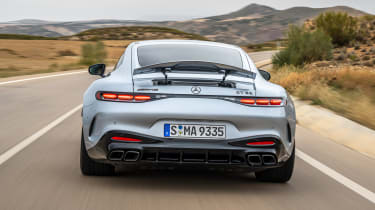Mercedes-AMG GT 63 2024 review – is AMG’s coupe finally a Porsche 911 beater?
A new chassis, tweaked V8 and a larger, more practical interior provides AMG’s new GT 63 with everything it needs to take on the best in the business
The Mercedes-AMG GT was always a curious beast. Positioned between a grand tourer and a super-sports car it struggled to decide what it wanted to be. It was a schizophrenic torn between taking on anything from an Aston Martin DB11 to a Porsche 911 Turbo. As impossible tasks go, the original AMG GT had one.
Now there’s a new AMG GT that includes a pair of optional 911-esque rear seats and a larger boot – two core customer requests – which mean it’s 180mm longer and 70mm higher but the same width as the old car (the GT S, not the wider GT C). At 1895kg it’s also 325kg heavier, much of this down to the now standard fitment of 4Matic+ four-wheel drive and enough upgrades to the chassis hardware and software to make an engineer’s head spin in excitement.
> Mercedes-AMG GT 63 Pro 2024 review – a four-seat 911 GT3 rival?
Those of you who follow AMG’s product cycle in forensic detail will know the brand has had a less than smooth ride of late. As I’ve used the word ‘late’ we’ll start with the AMG One, which is the hypercar product many within the company would like to forget ever happened and others swear will never happen again. New C63 with its hybrid four-cylinder engine? That’s gone down as well as a mixed grill on the menu in a vegan restaurant. Then there’s the new SL, a car developed for the first time by AMG and which has fallen short of the expectations of those who have appreciated the elegance, refinement and classlessness of the Mercedes icon for the last 70 years. Finishing last in 2022’s evo Car of the Year was its low point.
More reviews
Group tests
- Porsche 911 GT3 RS (991.2) v Mercedes-AMG GT R Pro – battle of the road-racers
- Mercedes-AMG GT 63 v Porsche 911 Turbo S: all-wheel drive GTs go head-to-head
Reviews
- Mercedes-AMG GT63 Pro 2025 review – a four-seat Porsche 911 GT3 rival?
- Mercedes-AMG GT 63 S E Performance 2025 review – testing the fastest AMG ever
- Mercedes-AMG GT 63 2024 review – is AMG’s coupe finally a Porsche 911 beater?
- Mercedes-AMG GT R (2016-2022) review
- Mercedes-AMG GT Black Series 2021 review – crosshairs pointed at 911 GT2 RS
If you have concluded that AMG’s new GT is simply a coupe version of the SL, you have done so wrongly. While both cars share a considerable amount of componentry from their platforms up, the similarities stop there. Because while they were developed at the same time, they were done so as very individual cars. Every component that required changing was changed, and every piece of software that needed lines of new code (or SL code removed) was updated. According to AMG the GT is very much a sports car, the SL its GT car.
Back to the tech underpinning the GT63 (469bhp 55 and four-cylinder GT 43 variants are also available, but not in the UK, and a range-topping circa-850bhp E Performance will land on these shores soon enough). The four-wheel-drive system is hooked up to a nine-speed automatic gearbox, the latter no longer forming a transaxle as per the outgoing model. This is to free up boot capacity, so the ’box is now bolted to the back of the 4-litre hot-V twin-turbocharged V8, spending the majority of its time sending drive to the rear 21-inch wheels, with 50 per cent of the drive capable of being sent to the front axle.
Noise and emissions regulations mean the NASCAR soundtrack of AMG’s V8 has been banished – from the outside at least, because a microphone within the exhaust system pumps as much noise back to the cabin as possible, albeit all rather synthetically.
This noise reduction also means it’s hard to gauge the V8’s delivery. It remains a monumentally punchy motor, even though it’s hauling nearly two tons here, but the sound is such that there’s little change in tone and so in the first three gears a visit to the limiter is common. Power (577bhp) and torque (590lb ft) delivery isn’t as linear as you’d expect, with the initial flurry from tickover blending to a flatter mid-range surge before finishing with a burst to the red line. The 62mph benchmark arrives in 3.2sec and V-max is 196mph.
Hunt around in third, fourth and fifth and the 63 delivers serious 911-troubling space – not Turbo levels, more GTS – and you are quickly hooked into the process, pulling gears on corner exit to shrink the subsequent straight before the windscreen fills with scenery to remind you it’s time to switch to the left-hand paddle to start throwing some downshifts in. Once you’re in tune with the V8’s delivery, operating in its sweet spot is second nature and an unexpectedly rewarding process. While the M177 engine is a known component, AMG has still found areas to improve. A modified oil sump has been fitted, the intercoolers have been repositioned for improved airflow, and there’s new active crankcase cooling and higher boost pressure.
Leave the transmission in auto and it’s no slouch, the shift mapping intuitive both up and down the ratios, although, as is the case with all auto settings, upshifts are earlier and downshifts later than you’d instigate if you were shifting manually. If you do self-select the gear the steering wheel-mounted paddles (better than VW Group offerings, but still little more than elongated switches) require little effort – perhaps a little too little – and would benefit from being more tactile and ‘engineered’.
But it’s the GT’s chassis that carries the surprises and delight. Built on an all-new aluminium space frame with steel, magnesium and composites included within its construction, the increases in stiffness range from 18 per cent torsionally to 50 per cent transversely and 40 per cent longitudinally. The GT’s body, minus opening items such as doors, weighs 270kg and weight distribution is now 54:46 front-to-rear, where it was previously a 46:54 split. This is due to relocating the gearbox.
Forged aluminium multi-link front and rear suspension, which is more closely aligned with that of the outgoing Black Series model rather than the GT C, includes active dampers that are hydraulically linked across the chassis (if the offside front damper is under compression, the nearside rear will be in rebound), an active anti-roll-bar system, rear-wheel steering, an electronically controlled limited-slip rear differential and that four-wheel-drive system. It comes together to deliver quite the performance, although selecting the correct drive mode is crucial to extract the best from the GT63’s personality.
In Comfort and Sport the GT portrays some elements of its predecessor’s aloofness and is a far softer and more benign GT car than it was before, but overall is all the better for it. Some tyre noise resonates around the cockpit but there’s a mellowness to how the car flows, an easy-going approach where previously it would dart for an apex before falling over itself. Now there’s a fluidity to low- and medium-speed driving, a suppleness to its behaviour that makes it a more convincing GT car. Although, to accommodate those optional two rear seats the front passenger compartment has been moved forward by 200mm. Not only does this mean the acreage of bonnet real estate ahead of you appears to have shrunk, but front-seat occupants have less space to move around in than before. For the driver it means the loss of the ‘legs outstretched and backside on the rear axle’ sensation, while the passenger can’t stretch their legs out if they’re taller than 5ft 10in, even with the seat set as far back as it will go.
Despite the shift forward, the driving position is still evocative, with a high scuttle and window lines and enough bonnet ahead of you for some VLN grid vibes. The sense of sitting on the rear axle may have gone, but the associated loss of connection between driver and car is perceived rather than reality. Being a modern Mercedes the interior is still a mix of full-size central tablet screen that looks like an afterthought and a steering wheel overburdened with haptic controls. As with the SL, the new GT would benefit greatly from having a more classic approach to where and how its controls are positioned.
Where the new GT ups the ante over its predecessor is when you dial the modes up. Sport+ locks everything down, but rather than turning the chassis into a bobsled it adds precision and alertness. There’s more weight to the steering – more an attempt to suggest feel than anything else – but it suits the GT when you begin to hustle it along. The front end no longer feels like a distant relative and hunts into a corner with far more conviction. Although there’s plenty of grip from the Michelin Pilot Sport S 5 tyres you still find yourself making small adjustments to judge the level of purchase with the surface. With only up to 50 per cent of the engine’s torque fed to the front axle the GT63 always feels a resolutely rear-driven car, driving through a turn and exiting with a squat from the rear, albeit with plenty of traction unless you get greedy with your right foot or provocative with your hands.
The step up to Race mode feels more like when you go from Comfort to Sport rather than the larger leap between Sport and Sport+, the margin of difference between the two most extreme modes more nuanced. Race makes the GT angrier, sharper, more edgy, but not to the point of being snappy. It never feels anything but planted. And even across shockingly bad broken tarmac this stiffest damper setting remains calm and controlled rather than brittle and back-breaking; it’s an impressive performance.
Less impressive is the rear-wheel steering, which below 62mph turns in the opposite direction to the front axle and above that speed in the same direction. On a number of occasions during our test, when turning into a corner there’s what feels like a delay in the rear axle’s reaction. As you pass the apex and start to unwind the steering lock, the rear throws in a couple of degrees of opposing directional change, unsettling the car and setting the rear tyres shimmying across the surface. It behaves similarly when you brake deep into a corner: bleed off the brakes and apply the required level of steering angle and the rear overcompensates, unsettling the car and at times requiring some corrective interaction. It feels like the e-diff, which you can feel constantly working away as the torque load is spread across the rear axle, is out of sync with the rear-wheel steering, the former leading the charge and not allowing the latter to interject until the last minute.
It is, however, a characteristic that only manifests itself in Comfort and Sport modes. In the more dynamic settings there’s more linearity and fluidity in how the GT63 tackles a road. It’s not a car that takes well to being hustled, but it has a willingness to change direction with a clarity and immediacy that belies its size and heft. It remains settled and in control. That’s testament to the work AMG’s engineers have undertaken to inject the personality and character the old GT was lacking. Even the ESP system is an invisible driving aid rather than a nannying inconvenience, designed to support you as you push, nipping away in the background, rather than throwing a security blanket over proceedings regardless of whether you are only beginning to explore its lower limits or experimenting with the upper threshold of the chassis’ limits and your bravery.
Naturally there’s some serious stopping power required for a car of this weight and performance, so the GT63 is fitted as standard with 390mm discs and six-piston calipers on the front, 360mm and a single pistons on the rear. The standard iron/steel discs have a ceramic coating as standard but a full carbon-ceramic set-up will be an option. Initial brake feel and retardation are impressive, but at the midpoint the pedal hardens and requires a stronger shove to push through for maximum effect. The brakes feel durable but extended periods of heavy downhill stopping soon results in a softer pedal and a whiff of hot pads when you come to a standstill. Trackdays will require frequent cool-down laps.
The new AMG GT accomplishes the majority of its goals with a high degree of success. After the disappointment of the latest SL, there was concern that the GT would follow in its overburdened, confused tyre tracks. Thankfully it doesn’t. It’s a better grand tourer than its predecessor and a more engaging, characterful and precise sports car too. A rival for Porsche’s 911? For some quite possibly. It’s more exotic and bespoke in terms of looks, but it lacks that ultimate driver engagement Porsche puts first on its list of criteria. Its biggest challenge is the circa £160,000 price tag AMG is expected to charge in the UK, which puts it in 911 Turbo territory, yet the GT63 is closer to a Carrera 4 GTS in terms of performance and capability.
More derivatives will follow, including a track-focused replacement for the GT R and R Pro – most likely just one model rather than two – and the return of the Black Series. Based on this first drive the new GT is finally the car AMG originally promised it would be. Now it has to build on these new-found credentials.
Price and rivals
Available to order now, the new Mercedes-AMG GT is priced from £164,765 in the UK, £7200 less than its drop-top SL63 sibling. UK buyers can choose from Premium Plus, Performance and Launch Edition specifications at launch, all applying plenty of kit as standard – as a result, the only optional extras are new paint colours and the Driver Assistance package, which bring price to £173,565 in the top spec.
At the lower end of the GT price range is the £98,960 Lexus LC500, a GT that punches above its weight in terms of dynamics and refinement and has a glorious naturally aspirated V8. The GT 63’s nemesis in the eyes of AMG’s engineers is Porsche's £159,100 and £180,600 911 Turbo and Turbo S. Turbocharged, four-wheel drive and room for four(!) the 911 continues to prove to be a benchmark for so many.
Maserati’s new GranTurismo, at £163,000, has proven itself to be a worthy addition to the GT class with its plush interior, refined ride quality, effortless performance and dynamically strong chassis, but is closer in spirit to Bentley’s £186,160 Continental GT in terms of character.
Finally there are the heavy hitters: Aston Martin’s £188,500 DB12 and Ferrari’s £172,690 Roma. The former has defined a new niche in terms of being a super-GT, the latter remains one of Ferrari’s finest and near impossible to resist.
Mercedes-AMG GT 63 specs
| Engine | V8, 3982cc, twin-turbo |
| Power | 577bhp @ 5500-6500rpm |
| Torque | 590lb ft @ 2500-5000rpm |
| Weight | 1895kg (309bhp/ton) |
| 0-62mph | 3.2sec |
| Top speed | 196mph |
| Basic price | c£160,000 |










